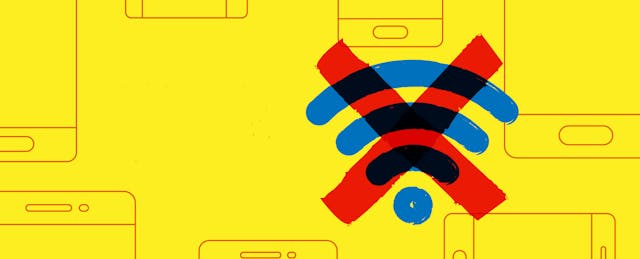Emergency online teaching. Remote delivery of instruction. Or just plain online learning. Call it what you will, many of the nation’s students are doing it in one form or another now that schools are closed coast to coast over the fast-spreading coronavirus. There’s just one problem: millions of students in the country don’t have a reliable way to get online.
“There's a big giant access issue, both in terms of what happens when there’s no internet and then also what happens when you don’t have a device that can go on the internet,” says Beth Holland, the digital equity and rural project director at the Consortium for School Networking, an industry group for school tech directors.
According to the most recent federal data, about 14 percent of households with school-age children do not have internet access. Most of those are in households that make less than $50,000 a year, and many live in rural areas. Among those who do have access, not all have a broadband connection. A separate Pew Research Center survey found that 17 percent of adults access the internet exclusively through smartphones.
That can make it tough to move to a digital workflow even when classes are meeting as scheduled. As recently as 2018, nearly one in five students said they had trouble completing homework because of internet access. These access issues make it a formidable challenge for districts to move instruction online in a pinch, even if enough computers could be distributed.
Already, the Northshore School District in Washington, the first in the country to move to emergency online instruction, has hit pause on the plan citing issues around equity. And Philadelphia’s school district has announced its equity concerns are big enough to forego any attempt at online learning in the first place.
But across the country, districts, service providers and even the federal government are easing the burden for unconnected families in an attempt to bridge internet access gaps at breakneck speeds.
Hotspots Heat Up
In the past week, many internet service providers, responding to the Federal Communications Commission’s “Keep Americans Connected” pledge, are waiving late fees for existing customers and increasing data caps for mobile hotspots, which link devices such as laptops to smartphones to provide internet access for both devices. Spectrum, one of the country’s larger internet service providers, is offering free service to new customers with K-12 or college students at home for 60 days; Comcast is making its Internet Essentials program, targeted at low-income families, free for the same duration for new signups.
In the case of Comcast, however, families must meet certain eligibility requirements, such as having a student registered for free or reduced lunch or taking part in another federal assistance program, says Norma Fernandez, the CEO of EveryoneOn, a nonprofit that helps connect schools and families with affordable broadband options. “That eligibility criteria really restricts low-income families and individuals from being able to connect,” she says.
Before putting its emergency instruction on hold, Northshore had already distributed 4,000 devices and around 600 mobile hotspots to families. Since hotspots don’t require installation, and their costs can be paid by districts, they’ve become an increasingly popular solution for districts in recent weeks, says Daniel Neal, the CEO of Kajeet, which offers a device called a SmartSpot that plugs into computing devices and can be configured to work with various telecom carriers. “It’s an enormous spike in demand,” he says of his company.
In the case of Kajeet, the cost per student ranges from about $15 to $25, depending on the data plan, with the hotspots themselves costing around $100 each, Neal says. He adds that a single hotspot can handle between four and six connected devices.
Of course finding the funds for such purchases is another story. Although the federal government makes funding available to schools and libraries in the form of E-Rate, that money can’t be used to pay for students’ home access or even solutions like Wi-Fi-equipped school busses parked in neighborhoods.
Groups including the Schools, Health & Libraries Broadband Coalition, which advocates for better internet access, have asked the FCC to relax its rules around E-Rate and to authorize emergency funding for hotspot rental programs—and to open up more of the wireless broadband spectrum known as white space. But these are short-term solutions, acknowledges John Windhausen, Jr., the organization’s executive director. If the coronavirus keeps schools shuttered into the fall, it may be better to start improving the country’s physical broadband infrastructure as a way to ensure lasting connectivity.
“Wireless solutions are best for the short run, but in the long run, as demand for broadband access grows, we’re going to need more and more wired solutions and fiber optic cable improvements,” Windhausen says. “We ought to start thinking now about how to get fiber to everyone’s home in order to provide that long-term access.”
The FCC hasn’t yet moved toward adding funding—though one FCC Commissioner, Democrat Jessica Rosenworcel, has indicated her support for many of Windhausen’s proposals. Beyond encouraging service providers to ease the burden for unconnected families, the FCC has temporarily waived rules prohibiting gifts from service providers to school districts that receive E-Rate funding, allowing districts to accept hotspot devices and increased broadband capacity if offered.
The FCC also relaxed rules relating to its Lifeline program, which offers discounted phone service for low-income families. That’s an effort to make it easier to enroll and keep service discounts. Yet it’s a challenge to make families aware that the program exists in the first place, says Kristina Ishmael at the education policy program at the think tank New America, who formerly worked for the U.S. Department of Education’s Office of Education Technology.
“We talked about Lifeline a lot,” at the Department of Education, she says. “But as a former classroom teacher and a digital learning specialist for the state of Nebraska, I didn’t even know about the program.”
Thinking Outside the Box
In addition to boosting internet connectivity, some schools and districts are reaching families using less connected, even analog means. In Los Angeles, a partnership between local PBS stations and the city’s district, LAUSD, spawned a remote-learning initiative tied to TV programs. Students in the area can now watch episodes of “Nova” geared for middle schoolers and Ken Burns documentaries that have been mapped to state standards. Others are distributing books and paper take-home packets that do not rely on internet connections.
Earlier this month, preschool students at the British International School in Hanoi, Vietnam, which has been using remote learning since February, received take-home boxes stuffed with homemade Play-Doh to develop fine motor muscles, craft materials like feathers, beads and glue sticks, and a list of games families can play together. Teachers in other grade levels are now curating boxes of their own.

“Teachers said the engagement from children was much higher than just using videos,” says James Buchanan, the school’s director of admissions, in an email to EdSurge. “They received many wonderful videos and pictures of children opening, playing and working with materials from the boxes.”
Holland, at the Consortium for School Networking, suggests schools keep in touch using text-based services like Remind, conference call lines and even old-fashioned phone trees. “I keep thinking about phones,” she says. “But not from an internet data standpoint, but actually making a phone call.”
While some districts are teaching students mainly online while making accommodations for offline students, Holland says this, too, requires careful thought and planning. “One of the other challenges is: How do you make sure you're not creating more equity issues between the online and offline,” she says. “How do you put value in paper and pencil?”


